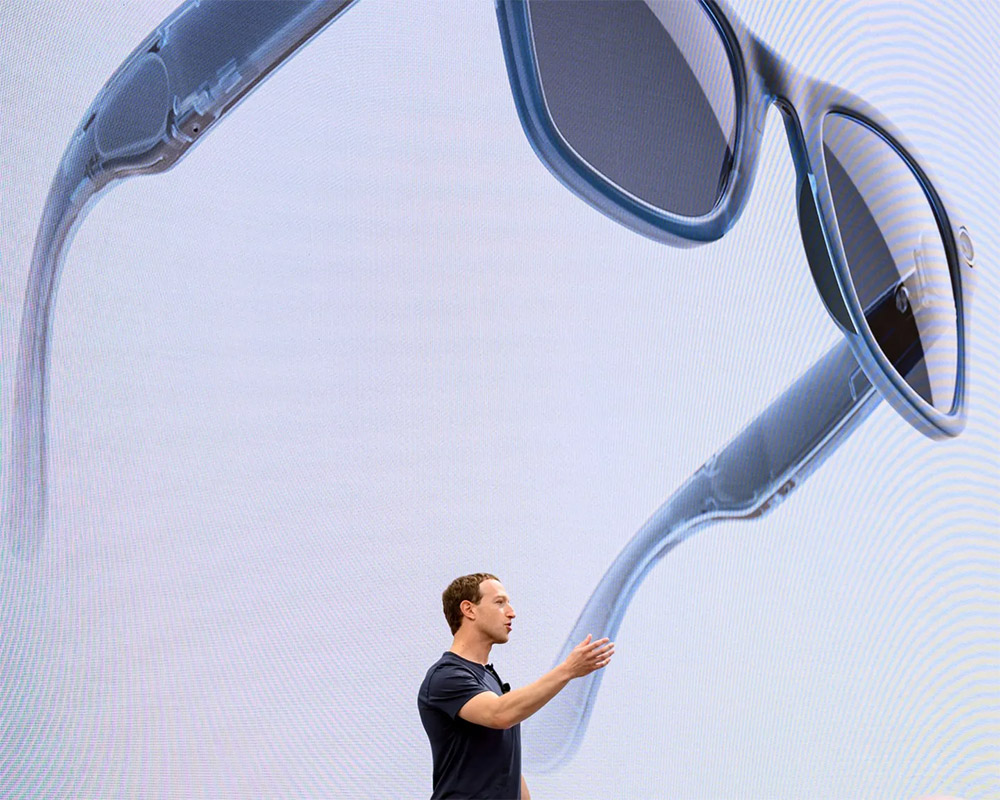
Meta内部正在进行雄心勃勃的努力,旨在为日益扩大的可穿戴消费设备产品线打造自研定制芯片,但这些努力最终还是未能逃脱公司持续削减成本的努力。
去年,当Meta仍深陷马克·扎克伯格(Mark Zuckerberg)所谓的“效率年”之际,该公司多年来为计划推出的可穿戴眼镜产品线自研芯片的工作实际上已经走到了尽头。两名熟悉该公司及其变化的知情人士告诉《财富》杂志,在公司大规模裁员和削减成本的努力中,定制芯片被认为成本过高,而且对芯片的需求也与当前的业务优先事项相去甚远。
其中一位知情人士称,Meta不再为智能眼镜设计芯片,而是转向了高通(Qualcomm)等第三方芯片制造商,为其即将推出的原型和潜在的未来版本AR眼镜提供芯片。
虽然Meta仍在继续设计其他类型的芯片,例如在其数据中心运行人工智能工作负载的专用处理器,但该公司从可穿戴设备定制芯片的撤出标志着始于2019年的雄心勃勃的项目的终结。这些芯片原本将是它们正在开发的可穿戴设备的基石,主要是代号为Orion的增强现实眼镜产品线。据其中一位消息人士透露,Meta仍计划在今年某个时候推出Orion AR眼镜的“实验性”原型,可能在未来几周,也可能是在9月份的Meta开发者大会“Meta Connect”上。
Meta拒绝置评。
Silicon团队助力扎克伯格实现愿景
智能眼镜和虚拟现实头显是扎克伯格未来计算愿景的核心。这位首席执行官最近预测,在不久的将来,将有数亿人使用支持增强现实和人工智能眼镜。
虽然Meta的绝大部分收入来自脸书(Facebook)和Instagram等各种社交媒体平台上的广告,但该公司已斥资数百亿美元打造消费硬件业务。名为“现实实验室”的团队在最近一个季度的营收仅为3.53亿美元,运营亏损为45亿美元。
Meta目前通过与眼镜巨头依视路陆逊梯卡(EssilorLuxottica)合作,销售一系列雷朋(Ray-Ban)智能眼镜。目前的版本包含一个摄像头和一个连接手机的芯片,但不包括AR功能,即直接在镜片上叠加数字信息。
在Orion项目的早期阶段,定制芯片被认为是获得扎克伯格最终想要的性能的必要条件。这位知情人士补充说,定制芯片主要用于Orion眼镜,以及正在开发的下一代AR眼镜,该项目名称为Apollo。Meta曾一度考虑在其广受欢迎的Quest虚拟现实头显中使用定制芯片,但这个想法很早就被扼杀了,就像为计划推出的智能手表定制芯片最终被完全否决一样。定制芯片也用于Apollo版眼镜。
可穿戴设备芯片的设计工作由Meta硬件部门的Silicon团队完成。知情人士告诉《财富》杂志,实际上,该团队正在为AR眼镜开发三种独立的芯片:一种用于“puck”, 即眼镜的非可穿戴处理器部分;一种用于眼镜内部,主要用于图像识别;以及另一个用于眼镜内部的处理器。其中一位知情人士表示,这些芯片的项目名称分别为Armstrong、Avogadro和Acropolis。他补充称,该公司曾计划开发一系列更小的芯片,如电源管理集成电路(PMIC),但也被放弃了。
一位知情人士表示,虽然前几年完成的一些定制工作有可能在未来的可穿戴设备项目中发挥作用,或者导致Meta使用半定制芯片,但该公司目前已转向依赖高通的“现成”XR芯片。高通还为Meta的Quest头显提供虚拟现实芯片。
至于这项工作背后的员工,自10月份以来,Silicon团队的数十名Meta员工已经被解雇。路透社最先报道了该团队的裁员。一位知情人士指出,一旦今年裁员完成,Silicon团队可能会被削减到只剩下与供应商沟通所需的“几位关键人物”。据路透社报道,为满足Meta不断增长的生成式人工智能需求而研发定制芯片的工作也遇到了麻烦。(财富中文网)
译者:中慧言-王芳
Meta内部正在进行雄心勃勃的努力,旨在为日益扩大的可穿戴消费设备产品线打造自研定制芯片,但这些努力最终还是未能逃脱公司持续削减成本的努力。
去年,当Meta仍深陷马克·扎克伯格(Mark Zuckerberg)所谓的“效率年”之际,该公司多年来为计划推出的可穿戴眼镜产品线自研芯片的工作实际上已经走到了尽头。两名熟悉该公司及其变化的知情人士告诉《财富》杂志,在公司大规模裁员和削减成本的努力中,定制芯片被认为成本过高,而且对芯片的需求也与当前的业务优先事项相去甚远。
其中一位知情人士称,Meta不再为智能眼镜设计芯片,而是转向了高通(Qualcomm)等第三方芯片制造商,为其即将推出的原型和潜在的未来版本AR眼镜提供芯片。
虽然Meta仍在继续设计其他类型的芯片,例如在其数据中心运行人工智能工作负载的专用处理器,但该公司从可穿戴设备定制芯片的撤出标志着始于2019年的雄心勃勃的项目的终结。这些芯片原本将是它们正在开发的可穿戴设备的基石,主要是代号为Orion的增强现实眼镜产品线。据其中一位消息人士透露,Meta仍计划在今年某个时候推出Orion AR眼镜的“实验性”原型,可能在未来几周,也可能是在9月份的Meta开发者大会“Meta Connect”上。
Meta拒绝置评。
Silicon团队助力扎克伯格实现愿景
智能眼镜和虚拟现实头显是扎克伯格未来计算愿景的核心。这位首席执行官最近预测,在不久的将来,将有数亿人使用支持增强现实和人工智能眼镜。
虽然Meta的绝大部分收入来自脸书(Facebook)和Instagram等各种社交媒体平台上的广告,但该公司已斥资数百亿美元打造消费硬件业务。名为“现实实验室”的团队在最近一个季度的营收仅为3.53亿美元,运营亏损为45亿美元。
Meta目前通过与眼镜巨头依视路陆逊梯卡(EssilorLuxottica)合作,销售一系列雷朋(Ray-Ban)智能眼镜。目前的版本包含一个摄像头和一个连接手机的芯片,但不包括AR功能,即直接在镜片上叠加数字信息。
在Orion项目的早期阶段,定制芯片被认为是获得扎克伯格最终想要的性能的必要条件。这位知情人士补充说,定制芯片主要用于Orion眼镜,以及正在开发的下一代AR眼镜,该项目名称为Apollo。Meta曾一度考虑在其广受欢迎的Quest虚拟现实头显中使用定制芯片,但这个想法很早就被扼杀了,就像为计划推出的智能手表定制芯片最终被完全否决一样。定制芯片也用于Apollo版眼镜。
可穿戴设备芯片的设计工作由Meta硬件部门的Silicon团队完成。知情人士告诉《财富》杂志,实际上,该团队正在为AR眼镜开发三种独立的芯片:一种用于“puck”, 即眼镜的非可穿戴处理器部分;一种用于眼镜内部,主要用于图像识别;以及另一个用于眼镜内部的处理器。其中一位知情人士表示,这些芯片的项目名称分别为Armstrong、Avogadro和Acropolis。他补充称,该公司曾计划开发一系列更小的芯片,如电源管理集成电路(PMIC),但也被放弃了。
一位知情人士表示,虽然前几年完成的一些定制工作有可能在未来的可穿戴设备项目中发挥作用,或者导致Meta使用半定制芯片,但该公司目前已转向依赖高通的“现成”XR芯片。高通还为Meta的Quest头显提供虚拟现实芯片。
至于这项工作背后的员工,自10月份以来,Silicon团队的数十名Meta员工已经被解雇。路透社最先报道了该团队的裁员。一位知情人士指出,一旦今年裁员完成,Silicon团队可能会被削减到只剩下与供应商沟通所需的“几位关键人物”。据路透社报道,为满足Meta不断增长的生成式人工智能需求而研发定制芯片的工作也遇到了麻烦。(财富中文网)
译者:中慧言-王芳
Ambitious efforts inside Meta to build its own custom chips for use in an expanding line of wearable consumer devices fell victim to ongoing efforts to rein in company costs.
Last year, while Meta was still deep into what CEO and co-founder Mark Zuckerberg dubbed his “year of efficiency,” years of work on the in-house development of computer chips crucial to a planned line of wearable glasses effectively came to an end. Amid mass layoffs and cost-cutting efforts throughout the company, work on custom chips was deemed too expensive, and the need for the chips too far removed from current business priorities, two people familiar with the company and the changes told Fortune.
Instead of designing its own chips for smart glasses , Meta has shifted gears and opted to rely on third-party chipmakers like Qualcomm for its upcoming prototypes and potential future versions of the AR glasses, one of the sources said.
While Meta continues to design other types of chips, such as specialized processors to run AI workloads in its data centers, the company’s pullback from custom chips for wearables marks the end of an ambitious project that began in 2019. The chips were set to be the backbone of the wearable gadgets they were being developed for, mainly a line of augmented reality glasses codenamed Orion. An “experimental” prototype of the Orion AR glasses is still set to be revealed by Meta sometime this year, likely in the coming weeks, possibly in September at Meta’s Connect event for developers, one of the people said.
Meta declined to comment.
Silicon to power Zuckerberg’s vision
Smart glasses and virtual reality headsets are at the center of Zuckerberg’s vision for the future of computing. The CEO recently predicted that AR and AI enabled glasses will be used by hundreds of millions of people in the near future.
While Meta generates the overwhelming majority of its revenue from advertising on its various social media platforms, including Facebook and Instagram, the company has spent tens of billions of dollars building a consumer hardware business. The group, known as Reality Labs, generated a relatively scant $353 million in revenue and an operating loss of $4.5 billion in the most recently ended quarter.
Meta currently sells a line of Ray-Ban smart glasses through a partnership with eyewear giant EssilorLuxottica. The current version incorporates a camera and a chip that connects to a person’s phone, but does not include AR capabilities, which would overlay digital information directly on the lens.
When the Orion project was in its early stages, custom chips were thought necessary to get the kind of performance Zuckerberg ultimately wanted. The custom chips were intended for the Orion glasses, as well as a next-gen version of the AR glasses being developed, under the project name Apollo, the person familiar added. Meta at one point also considered using a custom chip for its popular Quest virtual reality headset, but that idea was killed early on, as was a custom chip for a planned smart-watch that was nixed in its entirety. The custom chips were intended for the Apollo version of the glasses as well.
The design work on the chips for wearables was done by the Silicon team within Meta’s hardware division. The team was actually developing three separate chips for AR glasses: one for the “puck,” a non-wearable processor portion of the glasses; one within the glasses, mainly needed for image recognition; and another processor within the glasses, the sources told Fortune. The individual project names for the chips were Armstrong, Avogadro and Acropolis, respectively, one of the people familiar said. There were plans to develop a line of smaller chips, like Power Management Integrated Circuits, or PMICs, that have also been abandoned, the person added.
While it’s possible that some of the custom work done over the previous years will be useful for future wearables projects, or lead to Meta using semi-custom chips, the company for now has switched to relying on “off the shelf” XR chips from Qualcomm, one of the people familiar said. Qualcomm also provides the VR chips used in Meta’s Quest headsets.
As for the employees behind this work, scores of Meta employees from the Silicon team have been laid off since October. Cuts to the team were first reported by Reuters. One of the people familiar noted that, once layoffs are complete this year, the Silicon team is likely to be whittled down to only a “few key people” needed to communicate with vendors. Work on a custom chip for Meta’s growing generative AI needs has also been troubled, according to reporting by Reuters.






